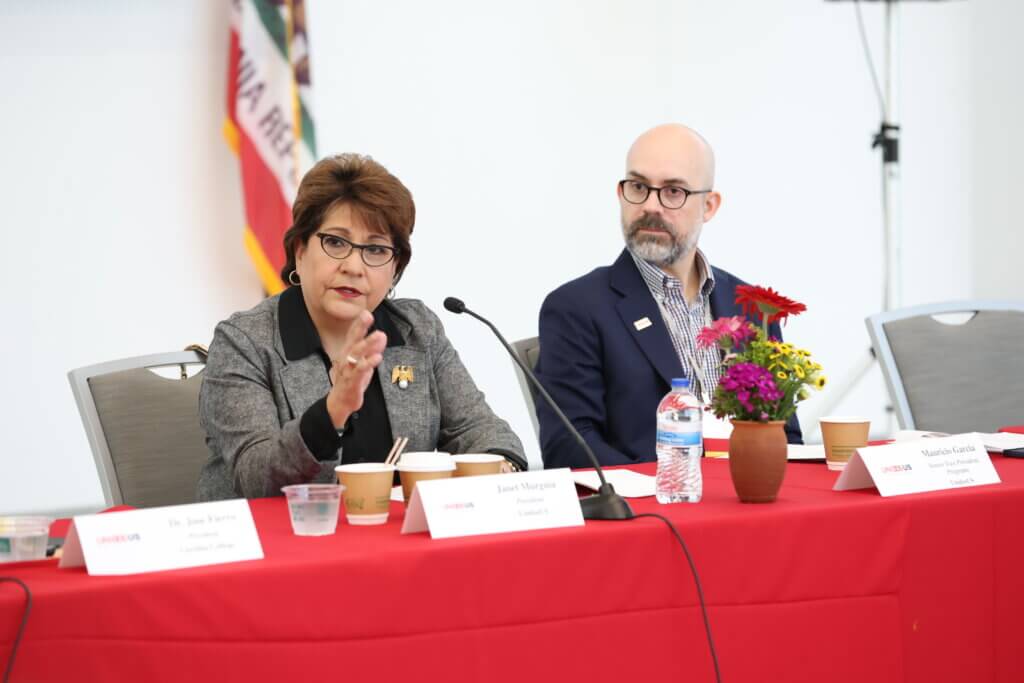UnidosUS’s new online higher-education hub offers a one-stop shop for Latinx resources
UnidosUS has just launched a new higher-education resource hub where policymakers, advocates, and the general public can readily access information to engage in key issues around Latinx postsecondary enrollment, college retention and completion, and student debt.
It comes with more than just easy-to-view facts and figures, uplifting the voices of Latinx students who share their stories. An emotive video published on the hub shows that obtaining a higher education degree is a dream for entire Latinx families since many parents of prospective students didn’t have the logistical or economic circumstances to go themselves.
“It would definitely be my parents and my grandparents. They weren’t able to attend college and my grandparents only attended middle school,” noted a Latinx student named Kate who appears in a Latino Stories video at the top of the webpage. “So when I go to college, it’s not only my dreams, but their dreams too.”
Other students in the video testimonials discuss the challenge of attending the U.S. school system while learning English as a second language, studying while working to contribute to their families’ household earnings and experiencing a sense of shame over not having the same access to information and resources for attending college as their more privileged classmates.
“I’m not going to sugarcoat it and say that it’s going to be an easy transition,” said another Latinx student named Lauren. “Have a community of people who can really help you transition into college and not feel that feeling of isolation.”
UnidosUS created this hub of online resources as part of its longstanding mission of advancing post-secondary education so that more Latinos have the tools to thrive in accessing career paths which can, in turn, provide Latinx families with dreams like home buying, child-rearing and retirement, and in many cases, greater opportunities for influencing the public policies that impact their communities. As it stands, between 2000 and 2020, Latinx students in the United States experienced a 164% increase in higher education enrollment, but getting to and through college is still a challenge.
Latinx Student Enrollment
Advocating for Latino students begins with understanding more about their particular enrollment experience, which differs greatly from their white, non-Latinx counterparts. For starters, they generally begin college later (average age 25), and they are far more likely than their white peers to be the first to attend college, at 70% compared to 45% respectively. About 60% of them receive Pell grants to fund their education, and while women make up more than half of college enrollment in white and Latinx student populations, the rate is especially high for Latinas: 60% for their demographic compared to 56% for white women. Within the Latinx or Hispanic community, most students are U.S. citizens claiming Mexican/Chicano or Puerto Rican heritage. Just under half a million students are undocumented, and of those, about half (48.5%) are Latino.
Latinx students are heavily represented in public and for-profit institutions, and many of them begin their degrees at two-year institutions, which analysts believe is due to the financial and logistical needs of a demographic of students.
“Because many Latinx students may be the first in their families to go to college and make decisions on when and where to enroll based on their family’s economic situation, it is not uncommon for them to delay enrollment in college, attend school part-time, and work one or more jobs while studying.,” explained UnidosUS Education Policy Project Director Amalia Chamorro. “This is why it’s important not just to focus on increasing their college enrollment but to ensure that they have the systemic and institutional supports to stay in college and complete their degrees.”
Latinx Student Retention & Enrollment
While it is true that Latinx enrollment has been on a tremendous upswing for more than two decades, six years after entering college in 2015, an estimated 51% of Latinx students had completed degrees compared to 69% of white students—a completion gap of more than 18 points.
Researching, applying for and choosing the right schools and programs with the strongest financial assistance and flexibility for attaining a degree is a complex process, and it all factors into students’ ability to stay the course in their programs.
“Me being the first one in my family, there was not a lot of guidance. I had to figure out everything and try to translate that for my parents. It was complicated, choosing a university I wish I had help to… really think through it,” noted a student in Minnesota quoted in the UnidosUS higher education report Following Their Dreams in an Inequitable System.
But that’s just the tip of the iceberg, say UnidosUS’s education experts. The hub’s data also shows that just 37% of Latinx adults aged 25 to 29 had associate’s degrees compared to 56% of white adults in the same age bracket, and when it comes to the BA challenge, those numbers dwindle to just 25% of Latinx adults compared to 45% of white adults.
Latinx Student Debt
Whether Latinx students graduate or not, they often accumulate extensive debt given that so many come from families with limited economic means. In fact, the data presented in the hub shows that at least 5.6 million Latinos hold federal student loan debt, with 67% of Latinx bachelor recipients owing an average of $25,524, and Latinx associates’ recipients owing close to $16,000. But the most disconcerting news for UnidosUS is that 91.4% of those bachelor recipients and 69.7% of those associate’s recipients owe more than their principal balance, with Latinx borrowers defaulting at rates higher than white borrowers.
UnidosUS education experts have found that this is due in part to poor career services support for Latino and first-generation students. Additionally, data from the Economic Policy Institute shows that Latino graduates earn about 85 cents for every one dollar that white graduates earn.
This data also raises concerns about student outcomes in for-profit institutions where Latinos are overrepresented. While students may be enticed to enroll in institutions that offer greater flexibility in online, weekend and evening courses, as well as more trade-focused training than traditional schools, research has shown that too often these degrees do not lead to gainful employment and make it harder for borrowers to pay off their loans. Default estimates go as high as 57% for Latinx borrowers who attended for-profit schools compared to 8% at schools that are non-profit and 35% at schools that are public.
Advocating for Better Outcomes
The final section of the online hub offers a set of state and federal-level measures that could improve the outlook for Latinx students in seeking higher education degrees, as well as a list of publications and resources where site visitors can obtain more extensive information and support.
This section encourages educational institutions and policymakers to take such measures as:
- making higher-education institutions more accessible and affordable to underserved populations
- improving the process for understanding and accessing financial aid
- engaging in equitable enrollment and culturally responsive educational practices
- requiring institutions to close racial and equity gaps by reporting how they are working to improve student outcomes
- ensuring that Latino students earn quality degrees across all institutions
“We hope that this online hub and the additional publications and resources it provides will contribute to greater public awareness and to developing a more equitable higher-education system for our increasingly diverse U.S. population,” said Sanchez.
–Author Julienne Gage is a former UnidosUS staff member and longtime contributor to ProgressReport.co.




